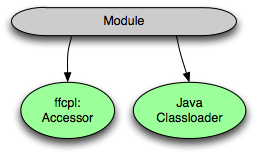Code First - Module
A NetKernel module is the fundamental unit of deployment. Like a regular Java JAR
file it contains physical resources such as code, classes and static resources but it also
declaratively specifies the logical URI address space that the module implements.
Physically a module exists either as a JAR file or as a directory.
The directory form is handy for development.
All elements of a module are easily available for editing
and can be managed by a code repository system.
The JAR form is valuable for distribution.
NetKernel includes a
Module Management Wizard which allows you to hot-install and remove modules in an operational
system.
which allows you to hot-install and remove modules in an operational
system.
Physically at runtime a module uses its own custom classloader
to bring its Java class files into memory.
Other physical resource are requested with the ffcpl: URI scheme. ffcpl:
is a little like file: only rather then obtaining resources from the host machines
filesystem, it references resources in the NetKernel modular address space.
Just like any other URI, ffcpl: URI requests are logically mapped
to a physical accessor that provides access to
the physical module resources.
(This is why these components are called accessors.)

The logical structure of a module is
defined by the metadata in the file
module.xml
which must be located in the root of the module.
The major sections of module.xml
are <identity>, <export>,
<rewrite> and <mapping>.
The mapping section defines the module's private internal logical address space.
If the mapping section is empty then the private address space is empty.
Each addition to the mapping section augments the address space.
The following ura entries map two points in the address space
to the two Java accessor classes used in the examples.
<module>
...
<mapping>
<ura>
<match>ffcpl:/helloworld</match>
<class>org.ten60.netkernel.tutorial.HelloWorld</class>
</ura>
<ura>
<match>ffcpl:/helloworld-java</match>
<class>org.ten60.netkernel.tutorial.HelloWorldSubRequest</class>
</ura>
...
</mapping>
</module>
These entries define the mapping between the logical address space
and the physical realm of Java code and objects.
This is a critical point and bears repeating.
Within a module a logical address
is mapped to a physical code
implementation of an accessor.
This is exactly how web servers work - they are sent a
logical resource address (such as www.1060research.com/)
and they send a response with a physical representation of
that resource (an HTML page in this case).
So then, how does the browser issued request in our
example end up as a request for the resource
ffcpl:/helloworld or
ffcpl:/helloworld-java?
We will look at this next.
In the module's rewrite section a rewrite rule
<rewrite>
...
<rule>
<match>ffcpl:/tutorial/(.*)</match>
<to>ffcpl:/$1</to>
</rule>
</rewrite>
will match all requests for resources starting with
ffcpl:/tutorial/... and rewrite them as
ffcpl:/... essentially
removing the /tutorial portion of the address.
For example, the request ffcpl:/tutorial/helloworld
will be rewritten as ffcpl:/helloworld
The module's export section contains:
<export>
<!---->
<uri>
<match>ffcpl:/tutorial/.*</match>
<match>ffcpl:/etc/HTTPBridgeConfig.xml</match>
</uri>
</export>
The export section defines the portion of the address space
exposed by a module for public use.
This declaration tells NetKernel that the tutorial module
exposes and will accept requests in the logical address space prefaced
by ffcpl:/tutorial/
as well as the specific resource identified by
ffcpl:/etc/HTTPBridgeConfig.xml.
Now we have part of the answer to our question about the browser's
access to the example code.
If the module is presented with a request for the resource
ffcpl:/tutorial/helloworld it will accept the
request, rewrite it as ffcpl:/helloworld
and then locate the HelloWorld class to
invoke its processRequest as the endpoint.
In the next section we will see how transports
provide the connection between the browser and our module.